Who Is Dick Lukkien?
FC Groningen have undergone a bit of a renaissance under their current manager Dick Lukkien.
With the club having suffered their first relegation in a quarter of a century just months after taking the job for the following season, it was a difficult situation that the then-Emmen manager found himself coming into, one that the club weren’t accustomed to being in.
Groningen had spent most of the last two decades as a traditionally top eight side in the Eredivisie, qualifying for Europe on a few occasions and even lifting the KNVB Beker once in that time.
A club also well known for producing some of the finest Dutch players to grace the game in the modern era, like Arjen Robben, Ronald Koeman, and Virgin van Dijk.
But following an abysmal 22/23 campaign where they only picked up 18 points en route to a miserable relegation, it was clear that a rebuild was in order under the incoming Lukkien, who had spent six years at the club as a youth coach and assistant in the early to mid-2010s.
Indeed, the club managed to bounce back immediately by securing promotion on the final day of the Eerste Divisie season in May.
They’ve also made a solid start to their return to the Dutch elite with the club ranking high in the European positions and boasting one of the better attacking forces in the league.
This analysis will take a look at how Lukkien style of play has restored the club back to the standards they had set for themselves over the years, less than 18 months after the worst season in their history which saw them go down a division.
Dick Lukkien Attacking Structure & Patterns of Play
Throughout Lukkien’s time at Groningen, the team has employed a 4-4-2 base structure both with and without the ball.
A scheme famously noted for its simplicity in terms of tactical setup, but there are some interesting things about the way Groningen perform within this structure.
Let’s take a closer look.
One of the key things to note is the way they build their plays from the back.
They start with both centrebacks moving wider to the edge of the penalty area and into the half-spaces, allowing the fullbacks to focus more on their offensive responsibilities and push higher up.
Both central players in midfield then drop deeper to offer support to the building phase, with the wingers inverting into the central zone and proving a presence in an advanced midfield area.
What this achieves is it allows Groningen’s fullbacks, typically captain Leandro Bacuna and AZ loanee Finn Stam this season, to attack the flanks more aggressively in spaces or 1v1 situations.
Having the wide areas all to themselves as a result of the positioning of the midfielders when in possession, allows them to get forward more and always provide an outlet for a switch pass towards the wings, which Groningen perform in abundance.
Let’s take a look at some examples of this setup in action.
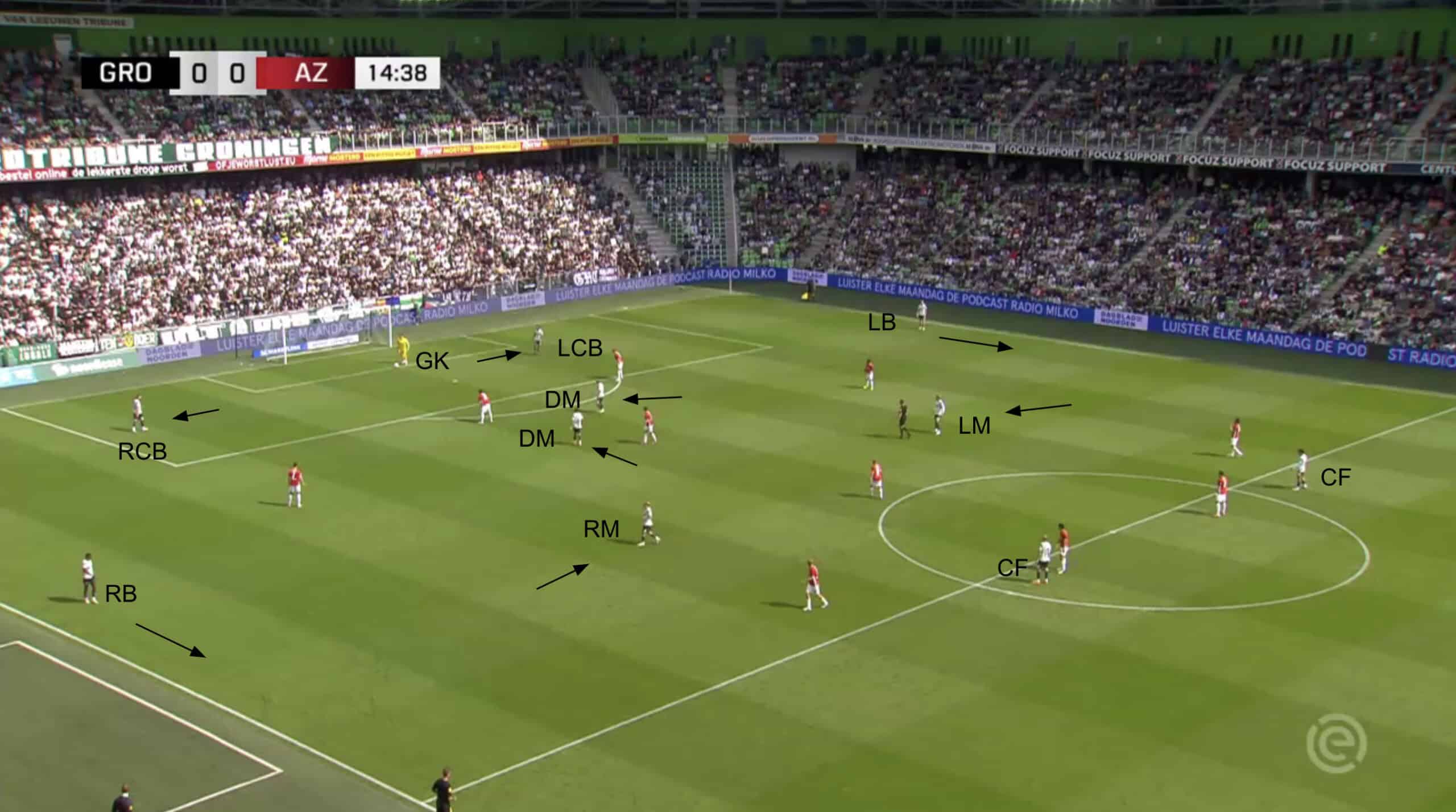
As we can see above with a full picture of the Groningen team with the goalkeeper ready to distribute the ball, we can see all the players taking up the positions as mentioned before.
The midfield becomes more narrow with the wingers inverting but allows them to access the central zone, which would be difficult to do with both pivots dropping so deep if they’re pinned back by the opposition, as they are here.
It’s also evident that Bacuna is a little more advanced on the nearest side of the goalkeeper, as for one, the attacks out wide tend to run through him but also as he is a more offensive-minded player than Stam, whose natural position is in central defence.
Stam has had plenty of experience learning to play in the left-back position while he was at Jong AZ, and is improving every time he plays, but Bacuna is undoubtedly the superior player offensively and that is why Groningen focus their wide attacks primarily through him.
This is by and large Groningen’s most consistent starting set-up when they begin to play out from the back, particularly against tougher opposition.
There is a small difference in how this appears against teams where they have more of the ball, as we’ll see below.
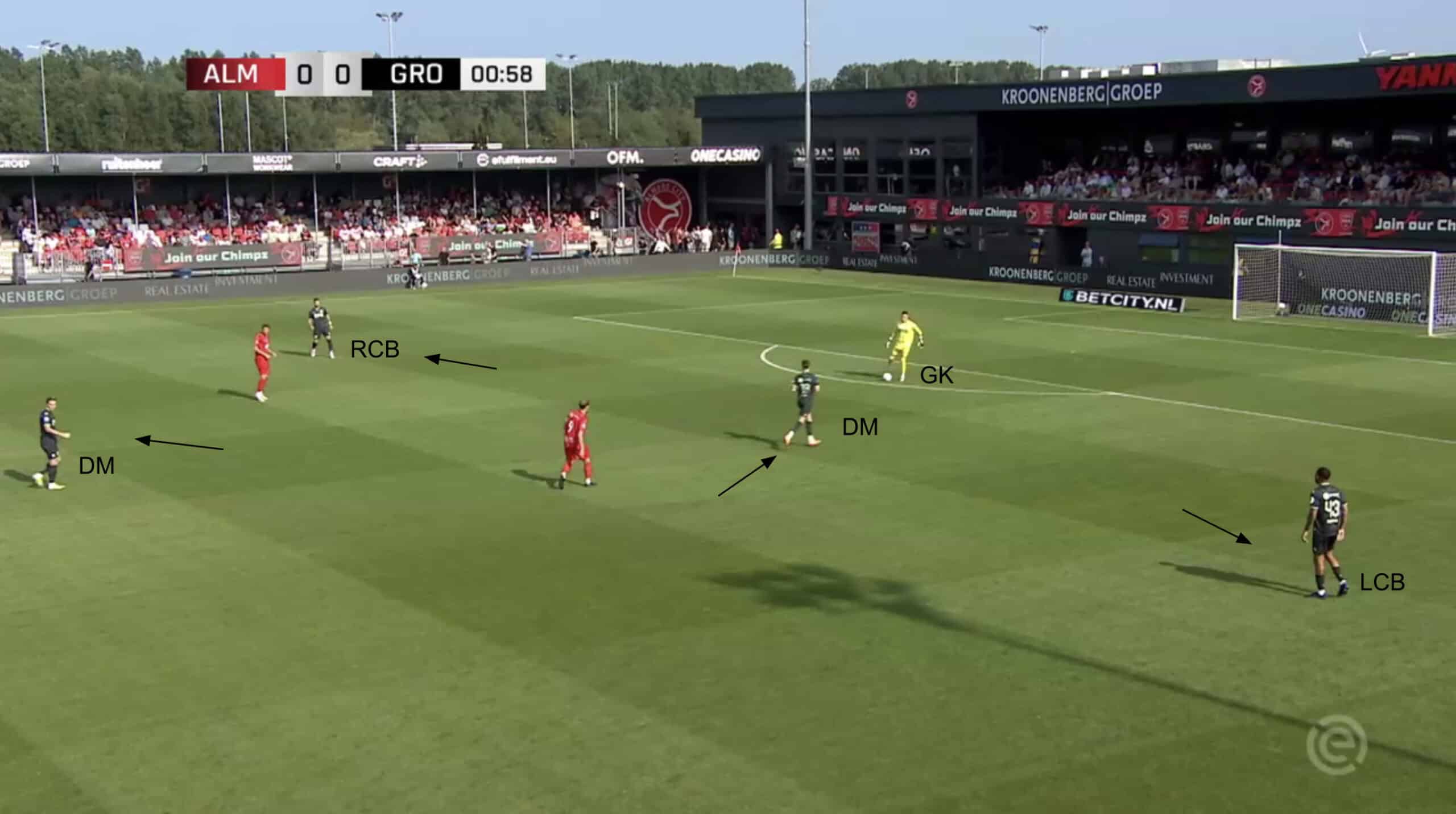
In this example, we see the slight variation of Groningen’s build-up structure that can occasionally be found in some games, particularly against weaker opposition such as Almere City above where they have more of the ball.
In this instance, we see Tika de Jonge dropping much deeper as almost a third center back to receive the ball in between the main pairing, while Johan Hove takes up a slightly higher position ready to push further forward.
What this small change allows is for an extra player to be present in a higher position as an outlet to progress the ball from deep, whilst also giving more license for the centerbacks to step up and carry the ball higher up the field should they receive it in those wider areas.
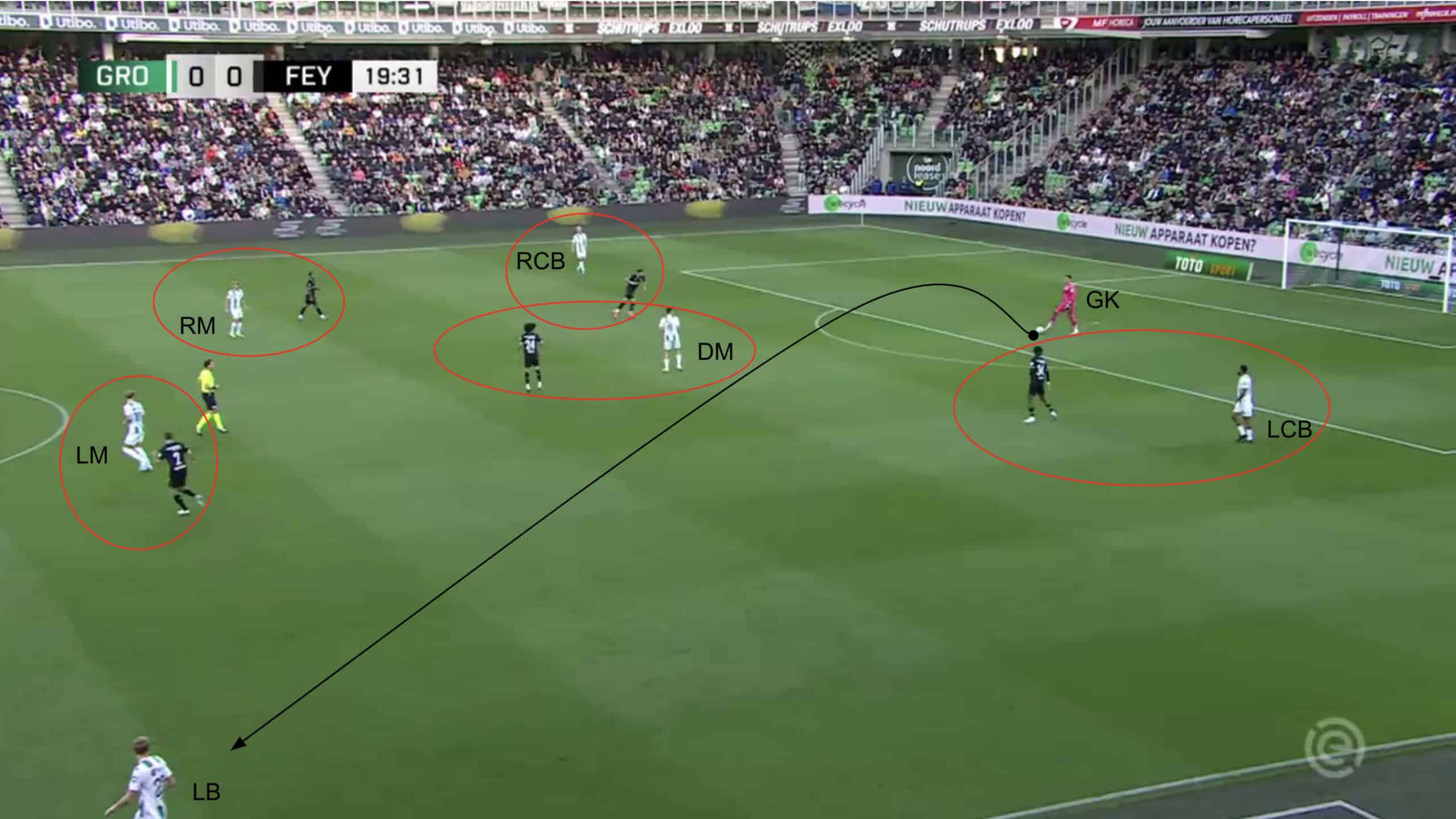
Another thing that’s been common besides their structure in the build-up phase is how the ball is typically distributed from the goalkeeper.
Whilst the main man between the sticks has changed since last season with young Surinamese international Etienne Vaessen coming in from Waalwijk in the summer to take the #1 spot, not much has changed in terms of what Lukkien requires of his goalkeeper in possession.
Both this and last term there’s been a common theme with the goalkeepers mixing it up between short and long passes when passing out from their penalty area.
We’ve noted some examples already of where the more obvious idea was to attempt to play short.
But due to how deep Groningen’s midfielders drop in this phase, sometimes playing out from the back is unreasonable with the opposition pinning them back higher up the field.
When this happens, the Groningen goalkeeper has no problem playing the ball long into an advanced position for the strikers, and inverted wingers joining behind them, to fight for.
This example from the Feyenoord game shows one of the instances where Vaessen goes long instead of attempting to try something risky out from the back where his team could cede possession in a dangerous area.
And as mentioned, Groningen aren’t abandoning their principles or identity when they do this, in fact quite the opposite.
They clearly welcome this mixed approach in progressing the ball, supported by the statistic that they average over 50 long passes a game since Lukkien took over.
So as noted, Groningen like to mix it up in how they play out from the back and try to provide midfield coverage through their inverted wingers as well as a platform for their fullbacks to attack into spaces out wide.
When the ball does get past the early build-up phase, what’s clear is just how much Groningen rely on being able to switch the play from one side to the other and always looking for spaces to attack or 1v1 situations to put their offensive players in.
Here’s an example of that below.
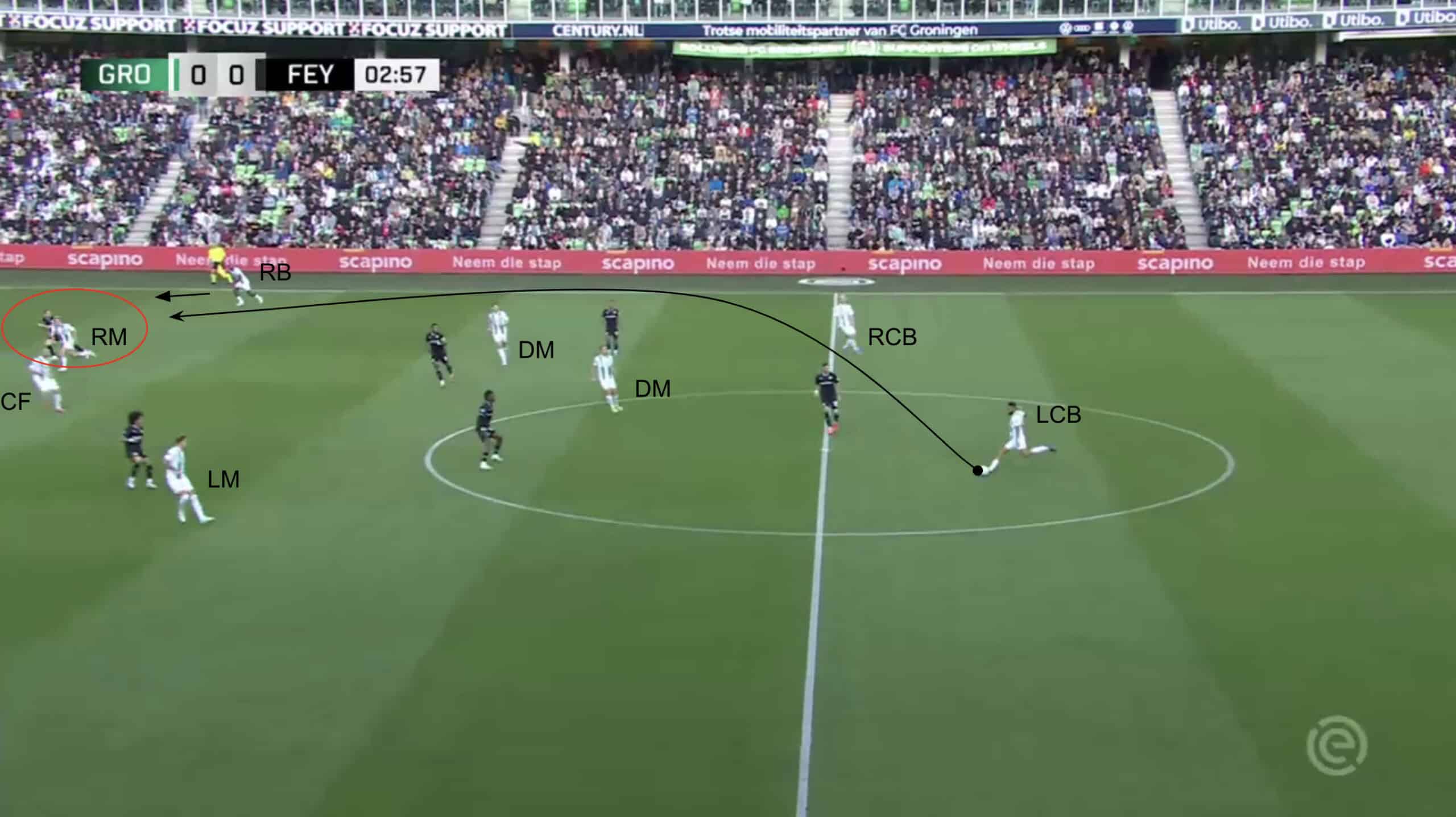
We can see a couple of things going on in this play.
First, we can see the wingers taking up more central positions, as noted before, in the final third which drags out a Feyenoord defender on the far side.
This leaves that flank open for Bacuna to run into, which is spotted by Marvin Peersman who makes the diagonal long pass towards him and puts him in a 1v1 situation on the ball to create an opportunity.
All in the early stages of the game, it’s a great example of what Groningen try to achieve with their attacking play: create spaces for their lateral players to move into and receive the ball on the underloaded side where they can get time on the ball to make things happen.
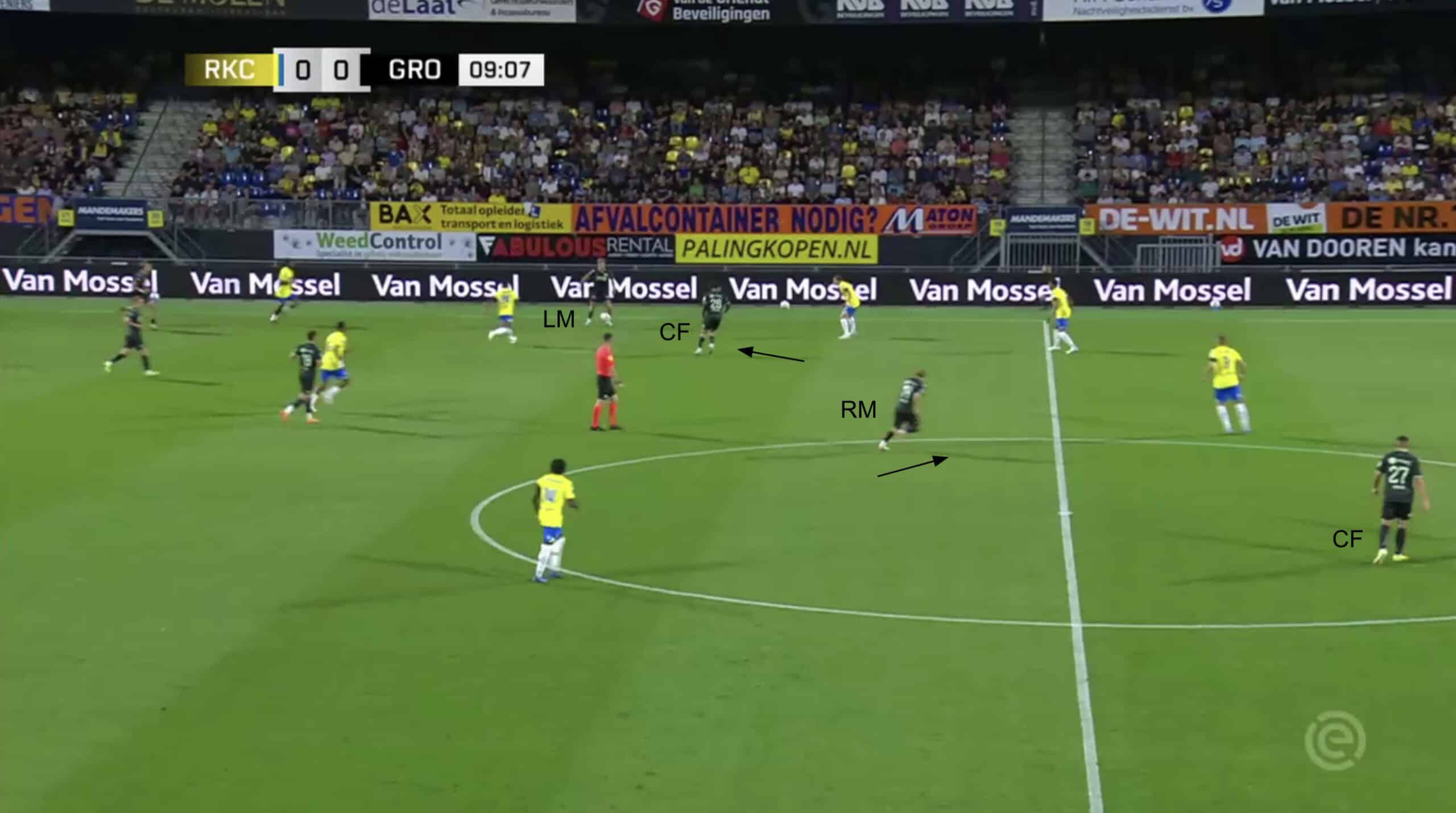
One thing that hasn’t been mentioned yet is the role of the two strikers in their 4-4-2 scheme.
While for the most part, both are tasked with staying up front to provide an outlet to receive the ball from wide or deep, they aren’t static in the way Lukkien wants them to play.
Oftentimes, at least one of the pair will move into the channels to try and get on the end of a long diagonal ball or support the attack on the near side out wide, which Thom van Bergen does in this example above against Waalwijk.
This example illustrates both of those points as van Bergen starts in a wider position to win his duel with the defender on the lateral pass from deep, before combining with Luciano Valente and carrying the ball forward on a run which results in a goalscoring opportunity.
Both forwards are capable of taking on this role, with both under 6 ft tall and comfortable taking on defenders with an adept low center of gravity, which provides different options for Groningen to attack through their frontmen with such profiles.
So far we’ve covered some of the main attacking patterns Dick Lukkien has drilled into this Groningen team.
Now let’s look at how things look more on the defensive side and with transitions.
Groningen Defending & Transitional Phases
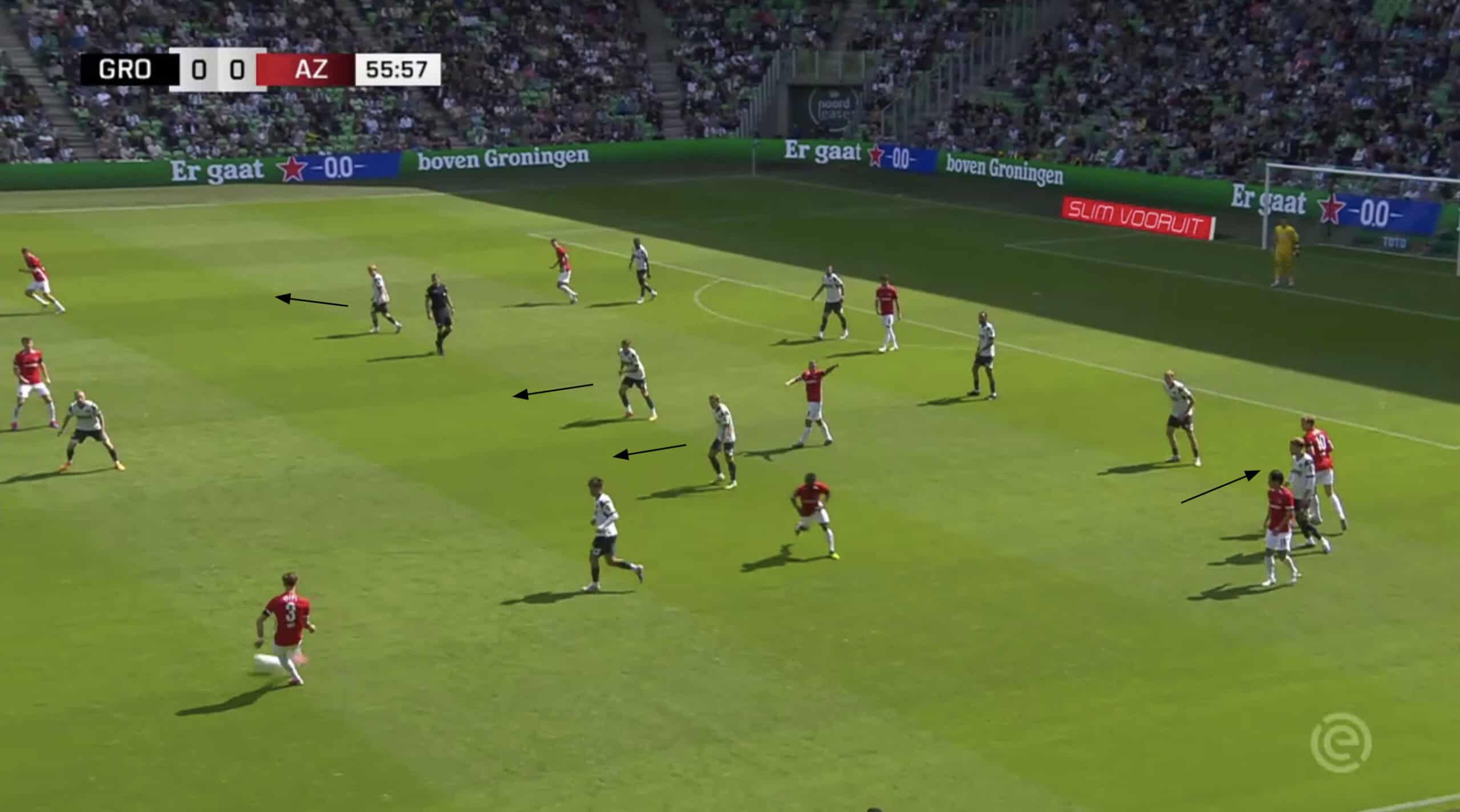
Off the ball, Groningen keep the same structure with a few differences when trying to defend versus trying to create and attack with the ball.
One of those is in how the wingers are positioned, as we can see above from the AZ game.
The near-side winger on the left is positioned much deeper in support of his fullback defensively in case AZ try to create any overloads on that side numerically, while the opposite far-side winger is ready to push up in case there’s a switch towards the AZ left-back.
Another difference we can see is how the central midfielders are pushing further up to be more in the same line as the wingers, thus creating a proper 4-4-2 structure.
This, along with the strikers dropping deeper to help out, makes it difficult for AZ to access the players in those central positions and forces them to go from side to side or backwards in possession.
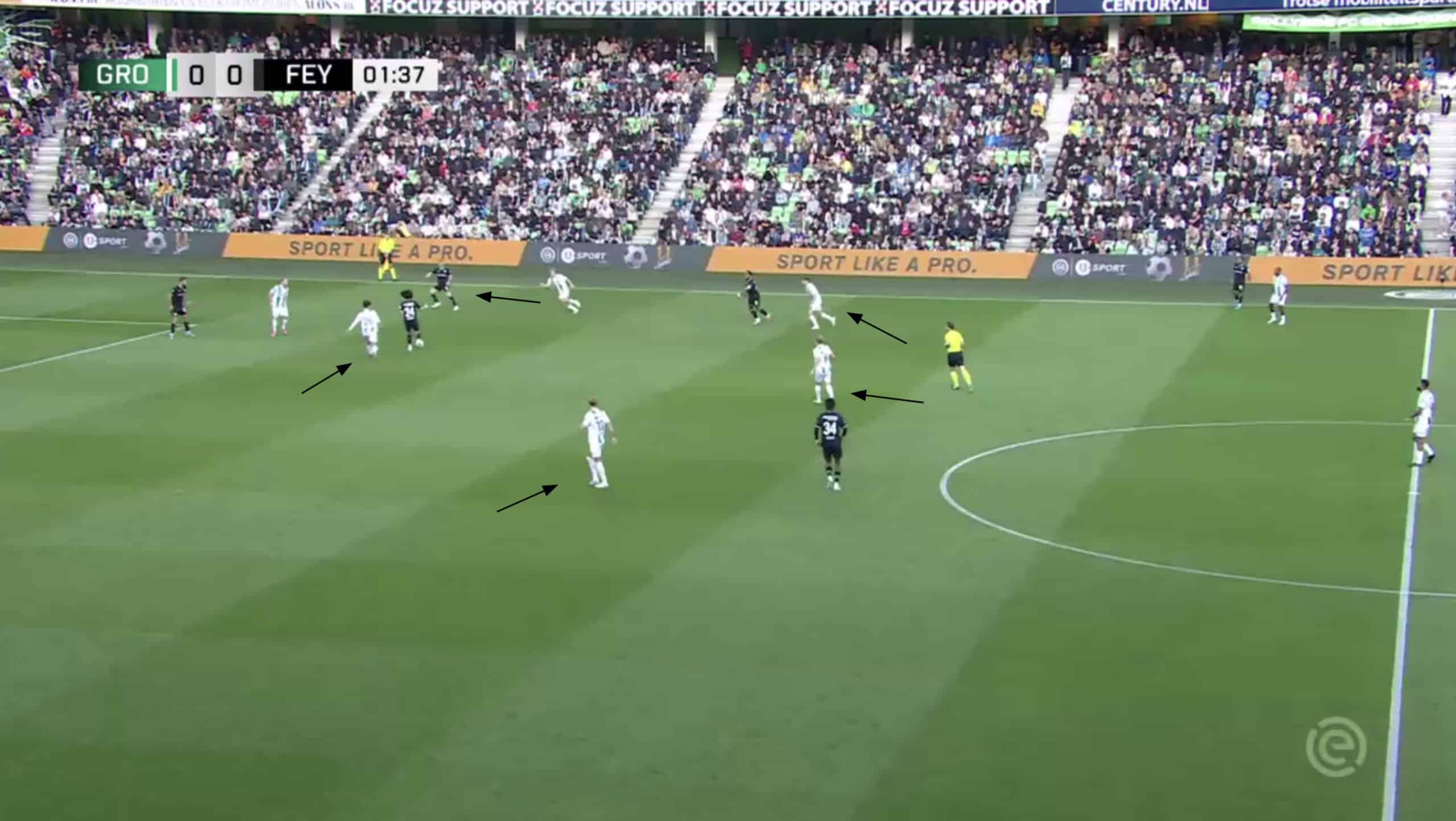
Another example of Groningen’s desire to defend higher up the field can be found above from the Feyenoord game where, again, you can see the midfielders pushing higher up the field and limiting spaces for the opposition to circulate the ball.
Here we can also see the near-side winger pushing up to deny the fullback time and space on the ball, forcing him into going backwards or a long ball forward, neither of which pose much threat to Groningen defensively.
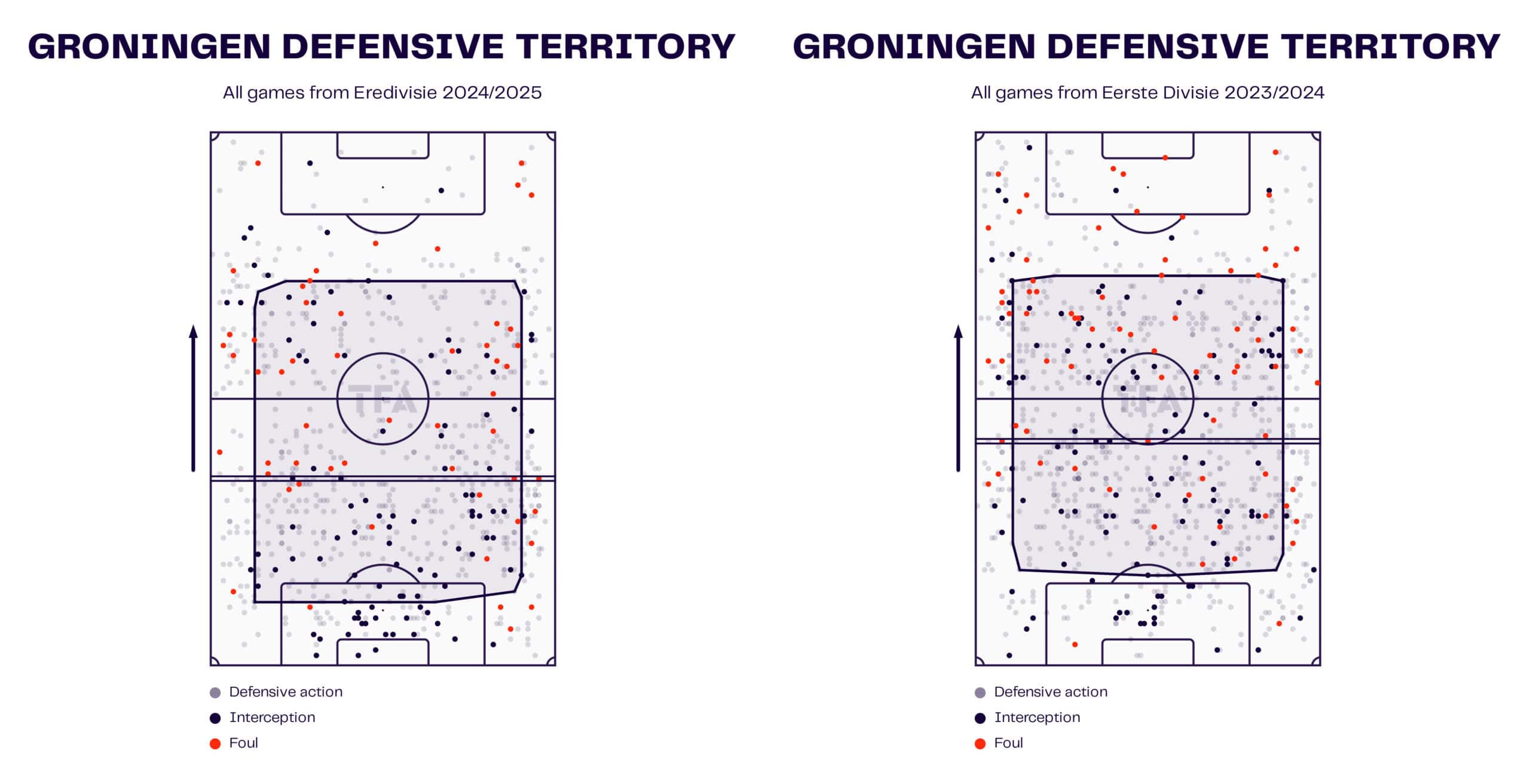
The data viz above compares Groningen’s territorial defending from last season to this season and as we can see, it’s almost exactly identical.
While they’re not an aggressive pressing unit, they are not one to sit back and let the opposition come at them.
Lukkien wants his players to push higher up the field and try to make it difficult for anyone to play through them, which is why they’ve been able to keep a solid defensive record under him as this way of defending will always limit how much opponents can hurt them offensively if they don’t have as much time and space on the ball as they’d like.
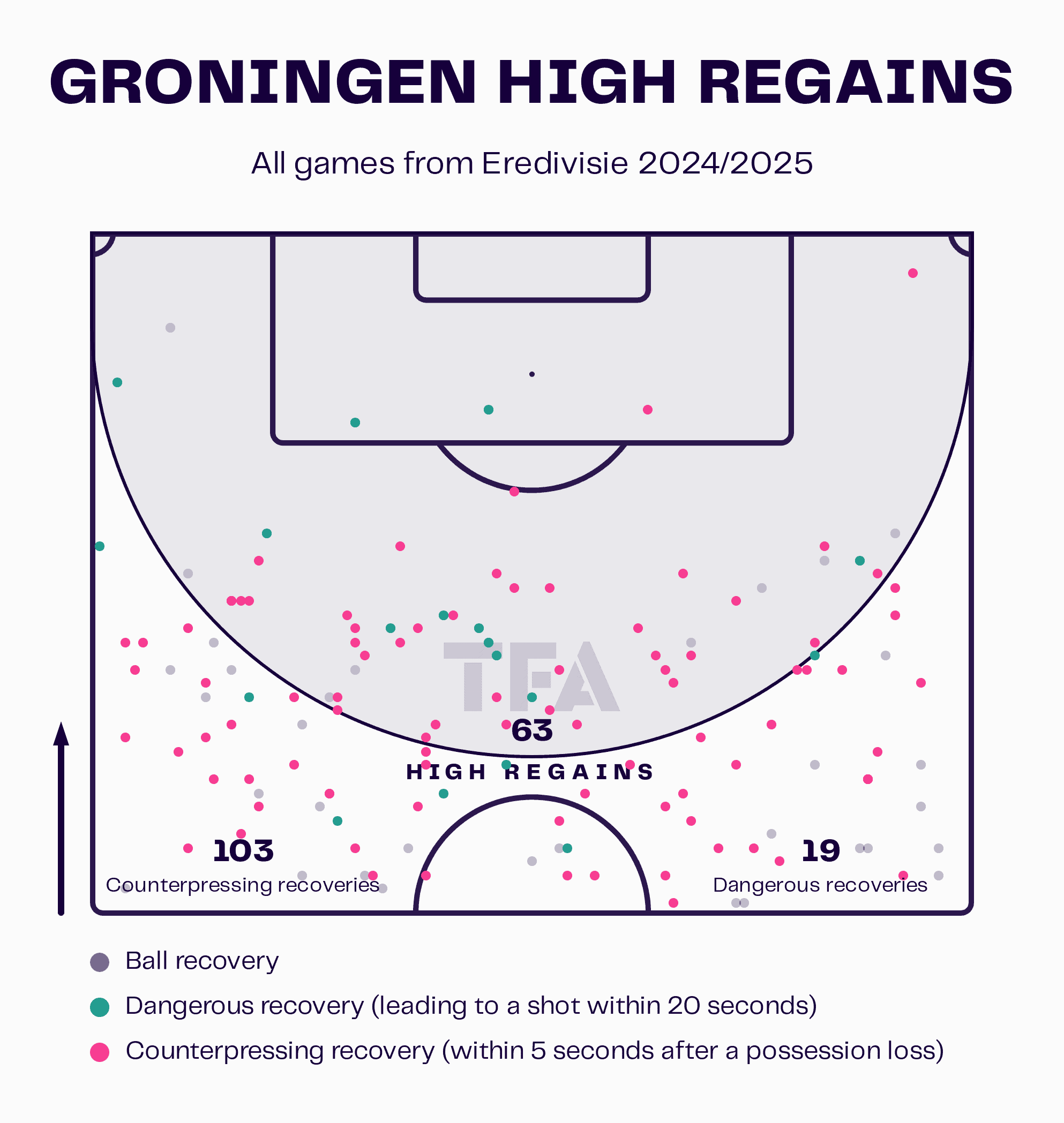
Here’s another data viz that supports the idea that their way of defending is working so far in their return to the Eredivisie.
Only a few games in now and they’ve already posted over 100 counter-pressing recoveries and 60 high regains, which are impressive numbers.
And given that the vast majority of their squad is aged 24 and under, it’s likely that they will continue to find success in this area and be able to keep up these high standards defensively.
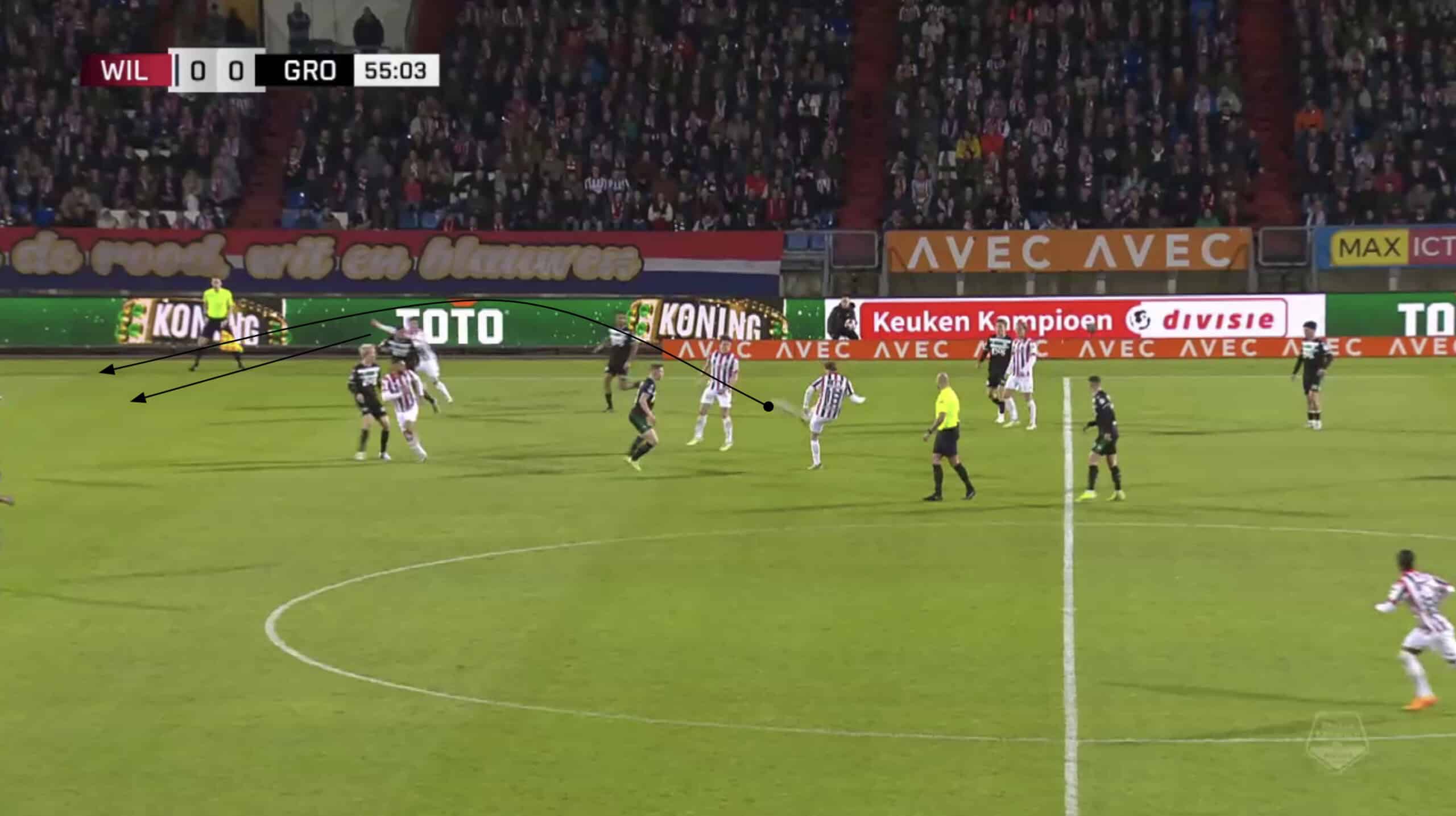
On the flip side of their defensive approach, there are some flaws that they still need to be wary of when committing men forward.
Often times when their fullbacks push higher up to attack, they leave spaces behind defensively that make the team vulnerable to dangerous counter-attacking situations.
The example above is from late into last season against Willem in a crucial promotion six-pointer, where they got caught out pushing higher up to defend a throw-in and this left space in behind on the left flank.
Willem took full advantage of the situation and scored to take the lead, and exposed the risk that comes with trying to push men forward to defend higher up the field like Groningen want to do.
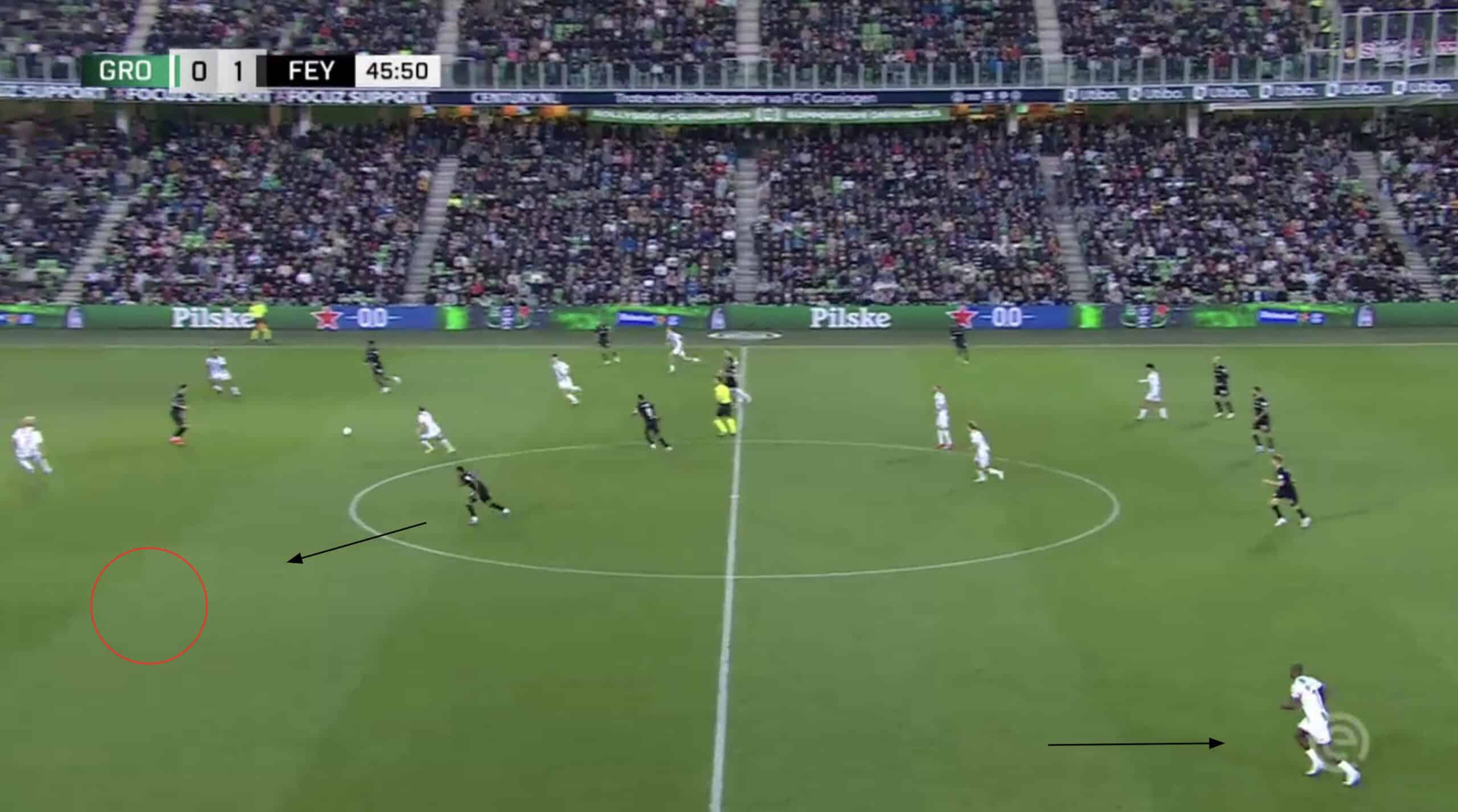
Another example of that from the Feyenoord game, although in this case it’s with Groningen on the ball that causes their undoing.
As we can see, Bacuna is very high up the field in this graphic, ready for a lateral switch pass to go 1v1 with the defender, but instead they concede possession and there is a huge gap on the right where Bacuna should be for Feyenoord to exploit.
It didn’t lead to a goal thanks to great goalkeeping from Vaessen, but it’s another warning sign of things that Groningen still have to tidy up if they’re going to play in this manner to make sure they’re protected in transitional phases.
Otherwise, playing this way against the top sides in the country could lead to a lot of dangerous chances given up.
Comparing Last Season to This Season
So as we’ve uncovered, on the surface, Lukkien’s side has strayed very little from the way they played in the second tier last year on their return to the top flight.
They’ve stuck with the same structure, same principles of play, and largely had the same results, even with a couple of changes in personnel here and there.
Below we’ll take a closer look at a few data viz comparing the side between both seasons to further examine whether there have been any deeper changes in what they’ve been doing.
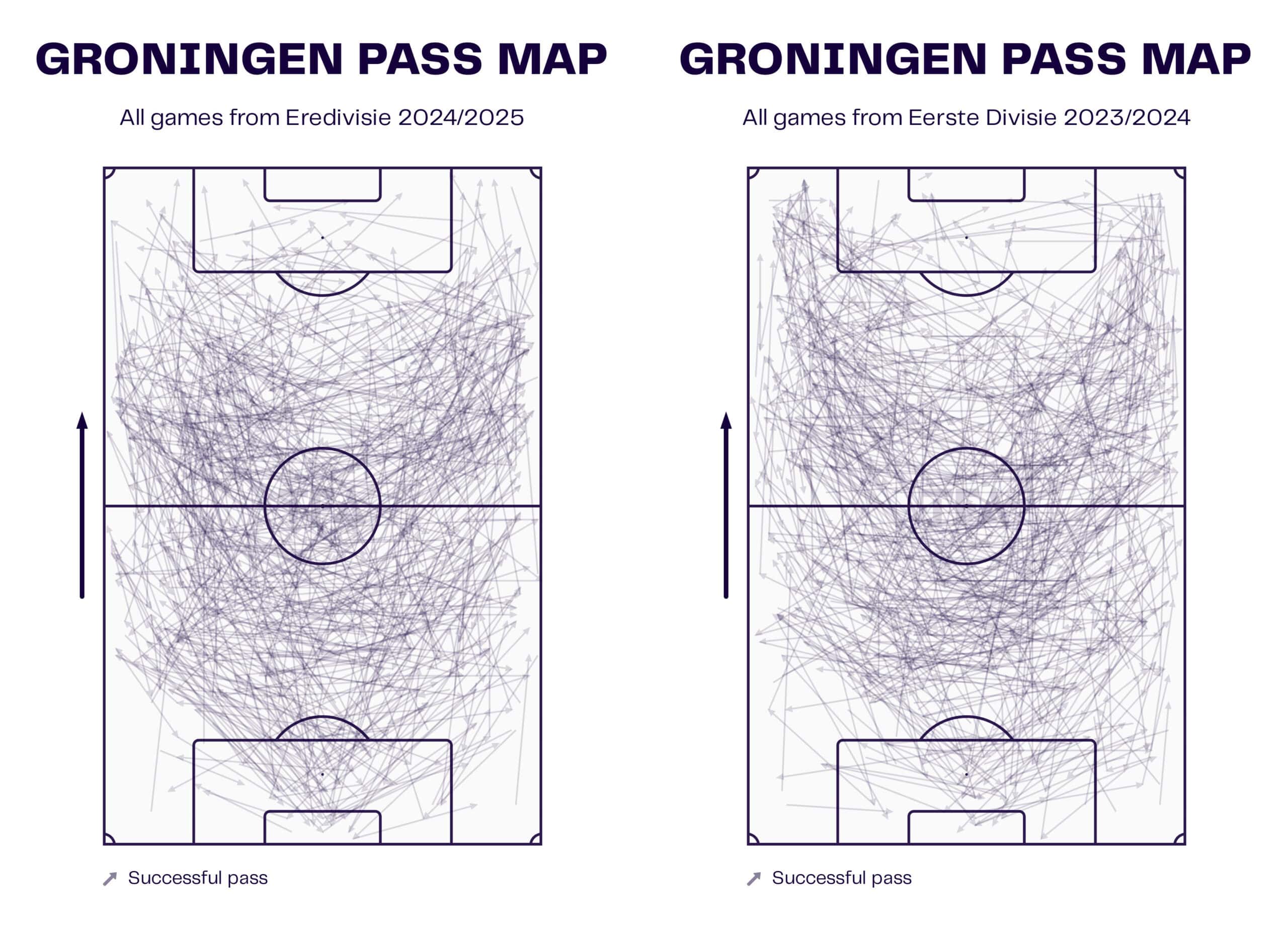
As we can see by the pass maps above from both seasons, once again both are mostly identical.
A heavy focus on lateral passes to players in space, mostly in wide areas, looks like it still remains their most common attacking pattern.
But there is a slight difference in the areas they access the ball in if we look below.
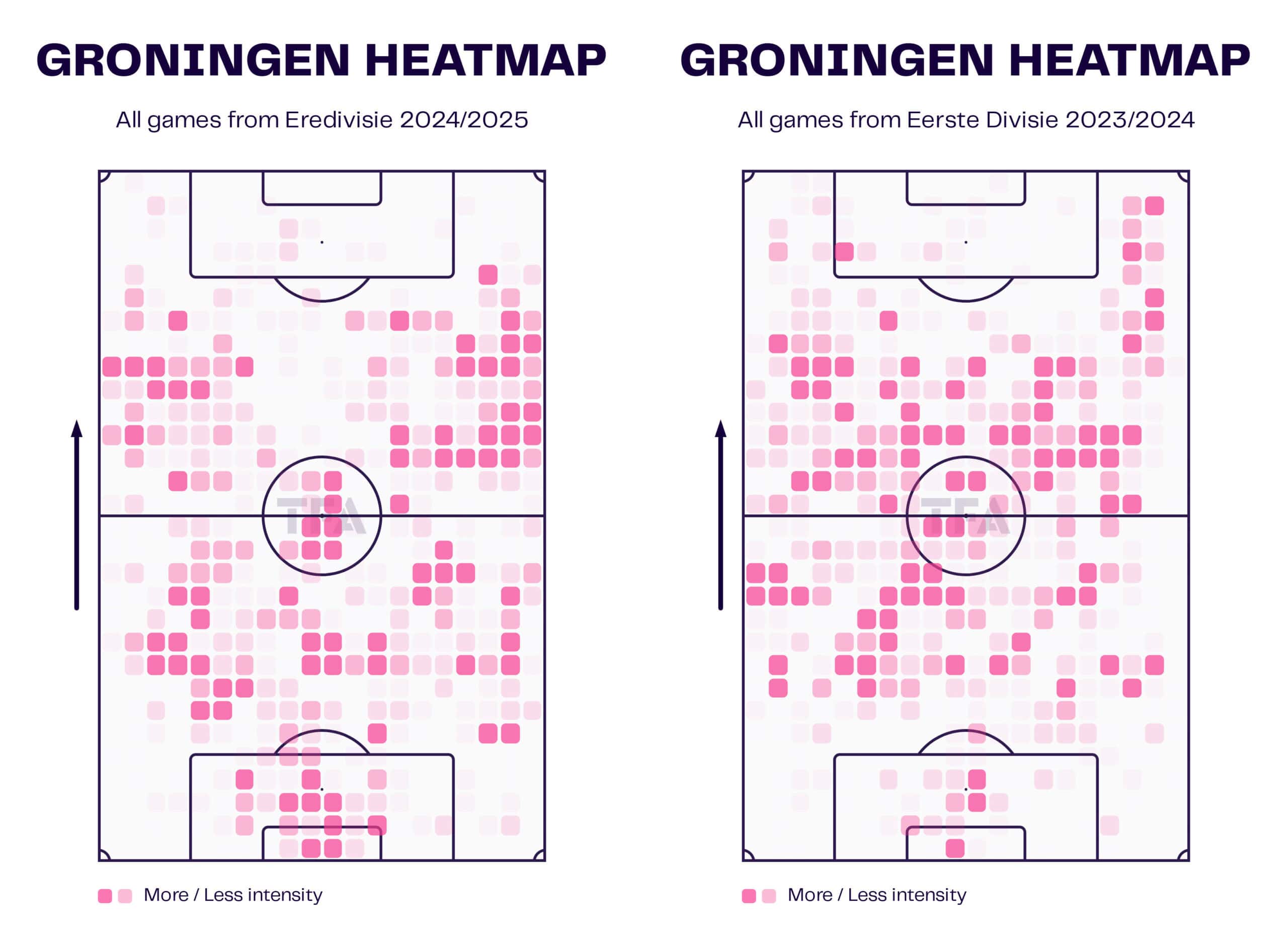
The data viz above shows Groningen’s heat maps across the two seasons, indicating where they see most of their actions on the pitch.
As we can see, Groningen had a lot more activity in the advanced central zones while playing a division lower, and are much more wide-oriented, and even wide-reliant, now in their attacking play.
Perhaps it’s the step up in opposition that’s made it more difficult for them to play through the middle, but it will be interesting to note whether they improve in accessing this area more effectively as the season wears on.
They have had less possession on average this season as a possible reason for this change, but they have also played a few of the top sides in the league already which may skew the data.
A case of time will tell, perhaps.
Conclusion
As this analysis has shown, Groningen have remained committed to their way of playing the game under Lukkien even after promotion and have continued to experience success in doing so.
Whether they will be able to maintain this good start, or even return to their old levels, remains to be seen.
This isn’t Lukkien’s first go-around with leading a team into the Eredivisie, having done it twice before with Emmen.
But it will be interesting to see how the 52-year-old manages things this time around with higher expectations at Groningen, who were traditionally contending for European football before their relegation.
At least they have a good platform to build on now with this good start and young squad at his disposal.

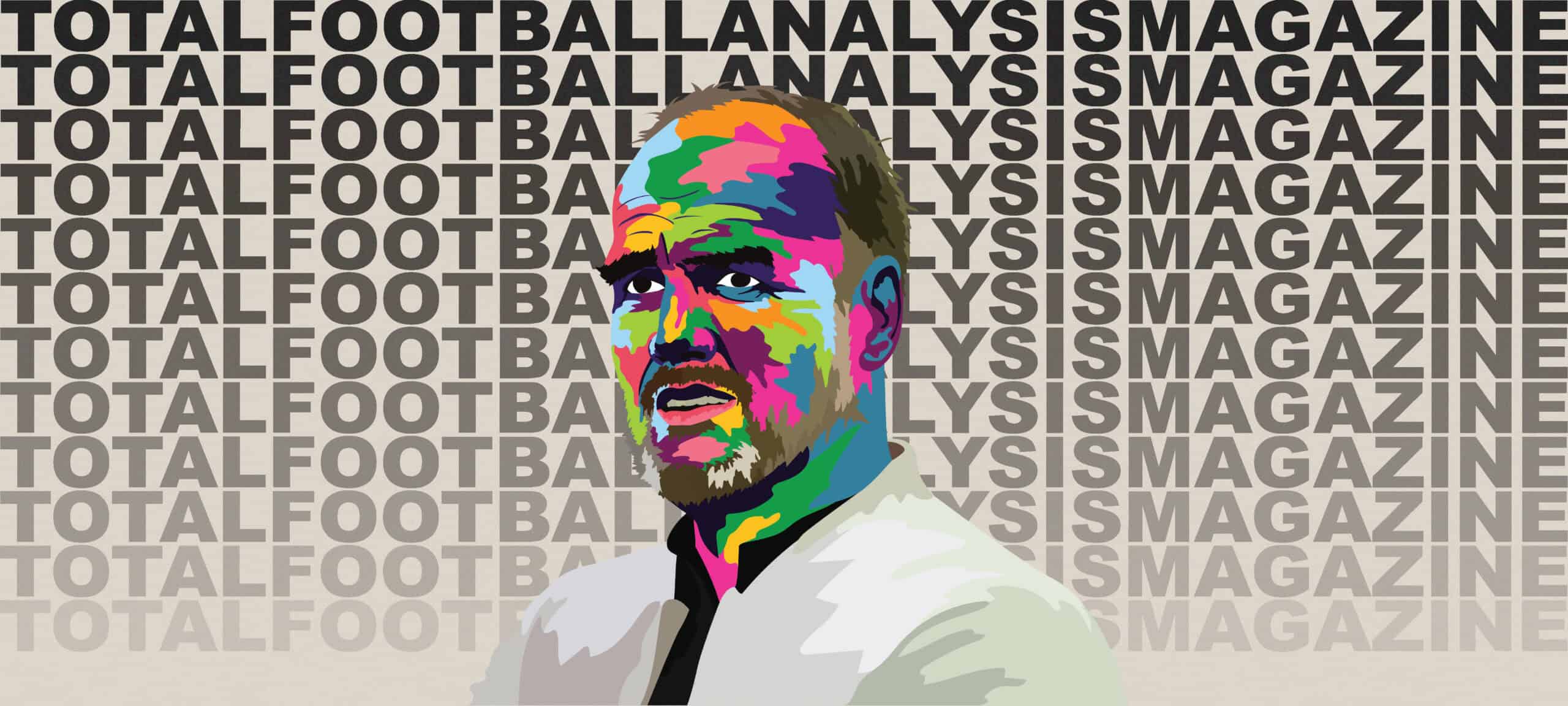




Comments